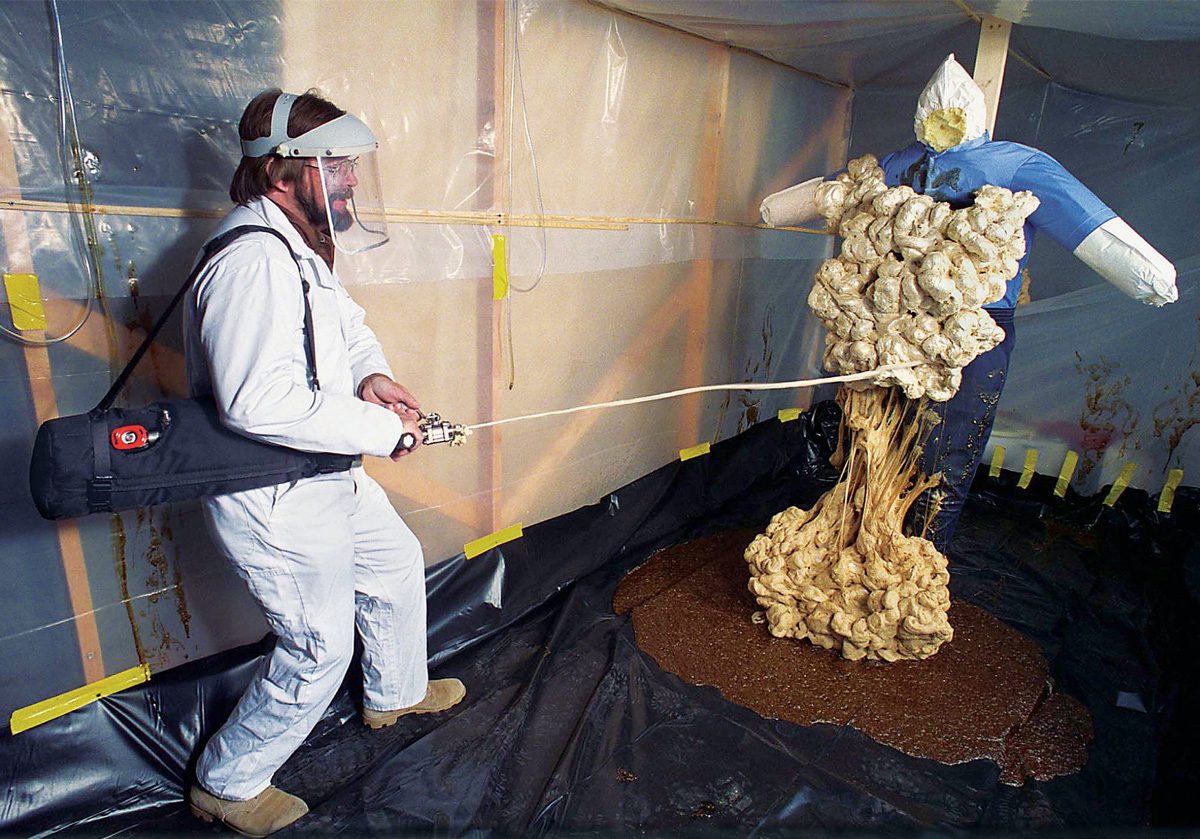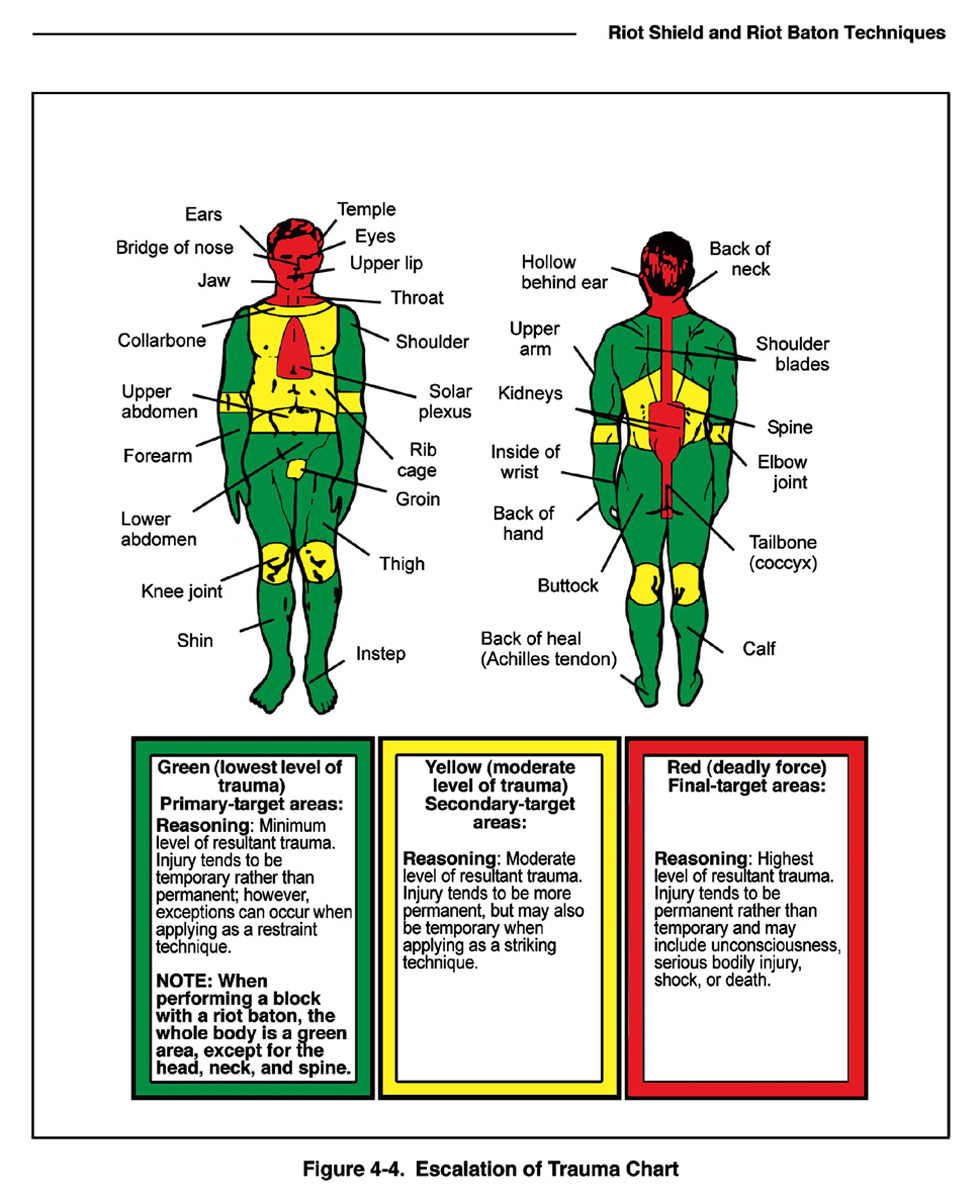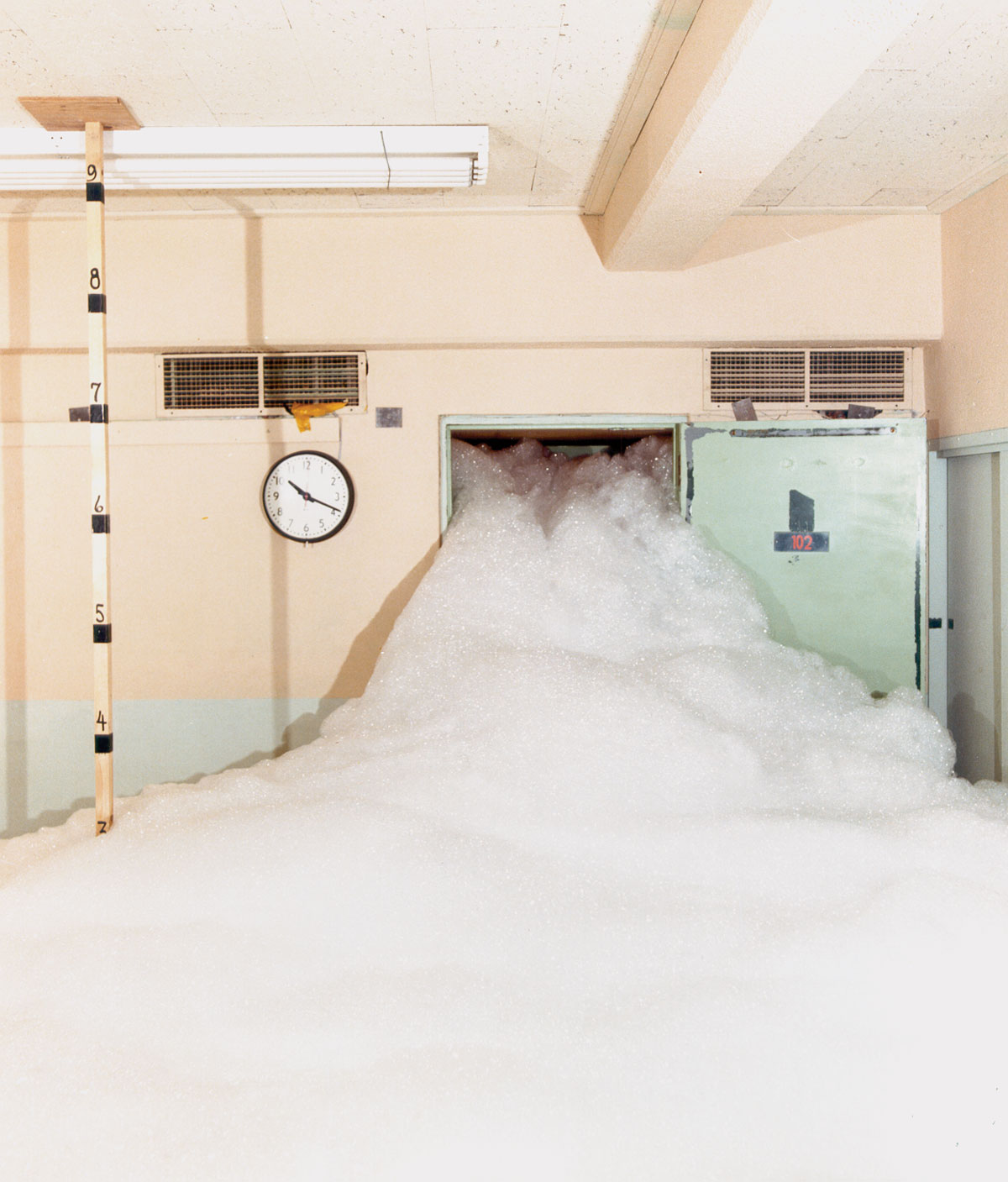Weapons of Mass Reduction
Viscous bubbles, sponge grenades, and the future of non-lethal arms
Gage McWeeny

In the mid-1990s, United Nations peacekeeping forces in Somalia were equipped with a new type of weapon to help troops contend with urban environments in which militia fighters often mixed with unarmed civilians. The new weapon was comprised of a tank to be worn like a backpack with a hose running from the tank to a gun with a nozzle on it. Rather than shooting bullets, this new gun shot streams of sticky chemical foam that would almost instantly immobilize someone with a heap of viscous bubbles, pinning him to the ground Spiderman-style without any lasting harm. The sticky foam gun was to be a new weapon of less destruction, a means of crowd control whose conceptual precursor was less rubber bullets and more Legion of Superheroes. Deployed to Somalia but never actually used on people by UN troops, the sticky foam gun nevertheless kind of stuck, as a vision of future warfare with less lethality.
After decades of life under nuclear threat in the Cold War, the sticky foam gun at once emblematized a messier world in which humanitarian intervention, peacekeeping, and war were becoming increasingly blurred, and also seemed like a hokey throwback to Cold War science fiction utopianism. The image of soldiers blasting away with soapy-looking foam instead of using riot batons was almost quaint. With the foam stored in silver cylinders mounted on backpacks, the sticky foam gun had a kind of campy James Bond jetpack look to it, like something from the future, if your present is, say, 1958.
But in this future, the weapons have been engineered to be less lethal to the same degree that they are used for engagement with crowds of non-combatants; that is, non-lethal weapons are made for use on what used to be called civilians before non-state conflicts turned everyone into either combatants or non-combatants. While the sticky foam gun has a kind of endearing utopian quality to it, a sense that peacekeeping operations might best be handled by Spiderman, the quaintness of sticky foam also may turn out to be part of a charm offense that softens us up to this new kind of war.
• • •
At least since Gustave Le Bon’s 1895 The Crowd: A Study of the Popular Mind, a work that popularized and distorted a host of nineteenth-century social theory and mass psychology into a vision of the fearsome arrival of “the era of the crowd,” there’s been a steady industry in efforts to understand and to control the crowd. Le Bon predicted a coming world of mass, if not quite mob, rule, with the crowd possessing a supreme social and political force. Now, the United States Army has its own new guide to crowd control, FM 3-19.15 Civil Disturbance Operations, published in April 2005. The army manual reads a bit like Le Bon’s own field guide, but with all the apocalyptic rhetoric carefully drained from it by the strictly-business language of military writing. The manual is at pains to point out to its users that the right to assemble is protected by the United States constitution, and it catalogues various outmoded, prejudiced understandings of how crowds behave handed down by Le Bon and his heirs, while putting forward its own more scientific taxonomy of the crowd. The Army manual is a compelling read, and through it one can learn all about the four different types of crowds (Casual, Sighting, Agitated, Mob-Like), as well as the various techniques and sophisticated forms of weaponry developed in recent years by the army to deal with them.
The military has at its disposal what Le Bon, not to say the Marx brothers, could never have dreamed of for the purposes of crowd control: sticky foam. Or, at least for a short time in the mid-1990s they did. When shot from a gun with a nozzle on it, sticky foam expands to thirty times its stored volume, and can glue a person to a surface with its super adhesiveness or just render them too gooey to move. In pictures, getting sticky-foamed looks roughly akin to being attacked by an enormous bag of marshmallows. In one photograph showing a demonstration of sticky foam on a US soldier, General Anthony Zinni, who oversaw the deployment of sticky foam guns in peacekeeping operations in Somalia, can be seen laughing as the soldier lies on the ground covered in foam, looking as much like dessert as subdued. With the appearance of a shaving cream fight gone bad, sticky foam has none of the publicity fallout of rubber bullets, which can kill if used at close range, and doesn’t result in the ominous and utterly broadcastable images of crowds of civilians being teargassed. After a person has been immobilized, the sticky foam, which is made out of rubbers, resins, oils, and flame retardants, can be removed, eventually, with hard scrubbing and baby oil.
Originally developed in the late 1970s by Sandia National Laboratories in New Mexico as a last line of defense to protect nuclear facilities from intruders, sticky foam is part of a new range of non-lethal weapons, weapons whose primary aim is to incapacitate while minimizing fatalities and permanent injuries. Non-lethals are the Marvel comics of military technology, as if a bunch of tech types were given the opportunity to develop the various superpowers of superheroes and supervillains into actual weapons. The new line of non-lethal weapons employs technologies far more exotic than bullets in an effort to do less damage. Low-frequency acoustical weapons, for example, can cause incapacitating nausea via sound waves. Something called the Active Denial System emits a quick burst of painful electromagnetic energy, causing lots of pain, but no lasting injury. Other new technologies include the Mobility Denial System, in which slippery fluid is sprayed from a backpack onto the ground, making the terrain impassable; sponge grenades; and self-destructing bullets that break up into painful, but not fatal, rubber balls before impact.
What’s driving all this non-lethality is a sense, beginning in the early 1990s, that the United States would need to adapt to increasing engagements in non-state warfare and peacekeeping operations. Some in the military pushed for technology that might better allow troops to deal with situations involving crowded, urban environments in which armed combatants mixed in with civilian populations. Such situations are referred to as “non-traditional battlefields,” and are part of what people in the business call Military Operations in Urban Terrain, or MOUT. As any image of US military involvement in Haiti, Kosovo, Somalia, or Iraq in the past decade or so shows, there’s been a lot more MOUT lately. And where there’s MOUT, there’s the increased possibility of non-combatant casualties. Non-lethal weapons advocates argue that this is the future face of war, and non-lethal weapons allow soldiers to take more appropriate, and more politically acceptable, actions in crowded urban areas when firing a gun with bullets or beanbags, or shooting teargas canisters, are not the only options.

In 1996, the United States Department of Defense issued a directive for the creation of the Joint Non-Lethal Weapons Program (JNLWP) to be overseen by the US Marines. (One of the features of US military writing is acronym-philia, which seems to come from twin but conflicting impulses toward brief, efficient communication and the endless expansion of agencies, protocols, directorates, etc., whose names are comprised of multiple words. The JNLWP website has a link to its list of acronyms. I counted forty-five.) All kinds of debates about the nomenclature of not-death surround the technical reports on these weapons. For the non-lethalists, the weapons are designed to incapacitate temporarily, so “non” is the appropriate prefix for something whose intended purpose is not to kill. The less-than-lethalists argue that anything, even a marshmallow, can be lethal, given the right conditions, and so the weapons should properly be called “less-than-lethal” in order to reflect their specifically disabling qualities, but without making any promises about non-death. But for sheer macabre semantic pleasure, it’s hard to beat “pre-lethal,” a term used for technology that is meant to stun or temporarily incapacitate combatants long enough for them to then be killed with a follow-up strike. Of course, all technology is, strictly speaking, pre-lethal, including marshmallows, since we’ll all die eventually.[1]
The JNLWP website contains plenty of photographs of American soldiers and weapons not being lethal. This non-, or less-than, lethality is transpiring for the most part among identifiably non-American, and basically identifiably Middle Eastern, people in the photos. Because the photographs are untitled and so generic in form and content, it’s hard to tell if the pictures are from training exercises or if they document actual engagements. In one picture, a soldier in a military vehicle appears to be having a heated exchange with a crowd of civilians who are slightly below him; the soldier holds out one hand in an apparent effort to either calm or repel the people gathered around him. In another, a man in a kaftan is shown reading a newspaper at an outdoor café, politely ignoring an American soldier a few yards away in front of a Humvee, who seems to be politely doing the same thing, albeit with a gun in his hand.
There are no captions to the photos identifying where or when they were taken, but of course, they all read as Iraq. The Cold War American sociologist Erving Goffman argues that such poses of polite indifference, what Goffman calls “civil inattention,” are crucial to maintaining zones of privacy for individuals amidst the crowdedness of city life. In an anticipation of late-twentieth-century non-lethal weaponry, Goffman credits such acts with preventing urban social life from being “unbearably sticky,” keeping us from innumerable unwanted social engagements with strangers on the street, or simply being swallowed up by the crowd. But, of course, daily life under peacekeeping, with restricted areas, curfews, checkpoints, and more, must be “unbearably sticky” for those who experience it. Under these conditions, sticky foam might be almost beside the point, or maybe just an apt, both cartoonish and real, intensification of what is already the point: mobility in MOUTs or under peacekeeping is restricted.
• • •
Once considered a joke by more hawkish types, non-lethal weapons are now a swiftly expanding industry, with military contractors evolving new technologies to accommodate the changing terrain of war. But these weapons also do a lot of much-needed psychic work in accommodating us to the future of a US military engaged in a series of protracted police or peacekeeping activities across the globe. If the weapons used in MOUT remind us of the powers wielded by superheroes, of 1950s technological utopianism, that little bit of campiness might be what makes us more able to live with superhero rhetoric about battles between Good and Evil. Sticky foam, with all its rich slapstick potential, is a non-lethal weapon that’s hard not to love. And who wouldn’t want to find some comfort or comic relief in such non-lethality after Abu Ghraib, amidst boobytraps, beheadings, and the rest of the horrors of post- (and pre-) invasion Iraq?
One can only dream of how history, film history, might have been different had Harpo Marx been among those first armed with a sticky foam gun. Or, more close to contemporary hand, and maybe more apt, Sandia National Laboratories need have looked no farther than Johnny Knoxville and the gang of masochistic Buster Keaton heirs he presides over in the film and television program Jackass for their sticky gun test subjects. (As it was, Sandia went, where else, but to Florida, and where else in Florida but to prisons, to test sticky guns as a crowd control tool for use on inmate populations). And one can only imagine, and in doing so no doubt still fall short of Knoxville’s own talents for imagining, the varieties of self-inflicted humiliation and gross-out dares, the kinds of sticky foam field tests that he and his crew might have performed on themselves, free of charge. In fact, Knoxville and company may turn out to have formulated a new genre for a new kind of wartime, something like Late-Imperial Slapstick. Laughing as Steve-o and the rest dare each other to snort wasabi through their noses, light bottle rockets out of their asses, and more, we’re no less horrified when we then see photos of prisoners being tortured by US soldiers. But we’re familiar already with the genre of the image, familiar enough with humiliation as filmable entertainment.
In 1997, Amnesty International reported on the use of electroshock devices similar to Tasers, which deliver a 50,000-volt shock, as instruments of torture in more than fifty nations. With little regulation or oversight of the use or distribution of electroshock weapons, their non-lethality is precisely the quality that makes them suitable for torture. What are the tools of torture, the stuff of Abu Ghraib and elsewhere, but the repurposing of official or improvised technologies into methods of applying precise amounts of painful non-lethality? Called into being by the convergence of military action and policing or peacekeeping, non-lethals are becoming increasingly popular with police forces for domestic use as well. Watching a news feed of crowds getting non-lethaled in a conflict on the other side of the world is familiar enough now, but that familiarity may become tinged with the unheimlich as non-lethality at home and abroad become harder to distinguish.
• • •
Recently, sticky foam has had a Cold War comeback moment, with the Department of Energy reportedly reintroducing it back into its old role of safeguarding sensitive areas of nuclear facilities from terrorist attack. Stored under pressure in metal containers within the steel doors of nuclear sites, sticky foam turns from liquid to solid upon exposure to air should someone attempt to break through the door. The attacker would be instantly coated with the stuff, slowing him down long enough for more responders to arrive.

In this new-old job, sticky foam acts as what security types call a “force multiplier”; in military terms, a factor or technology that increases the effectiveness of troops in combat. Sticky foam, ready to glom onto intruders at nuclear facilities, the argument goes, would allow the facility to increase security without having to hire more personnel. Having largely been retired from its use as a crowd control weapon in gun form (after Somalia, it was determined that the use of sticky foam in guns carried too great a risk of fatality from suffocation should the foam be sprayed on someone’s mouth or nose), sticky foam technology is now getting its own turn to function something like a crowd, allowing security personnel to multiply their force from that of the relative few into that of the many. Since Spiderman’s own super powers are the result of being bitten by a radioactive spider, there’s a nice symmetry to his non-lethal weapons avatar, sticky foam, being back in action at nuclear plants.
Whether other non-lethal weapons will limit fatalities and collateral damage in war and peacekeeping operations is an open question, but given how horrifying non-lethality can be when it takes the form of torture, such weapons may turn out to be one of the central moral problems for the war against terror. The very cultural work they do in acclimating us to the notion of war with less lethality may be their most dangerous aspect.
- For the true believers, non-lethal seems to have won the day. Retired Colonel John B. Alexander’s very useful book Future War: Non-Lethal Weapons in Twenty-First-Century Warfare is a kind of layman’s guide to, and polemic on behalf of, the centrality of non-lethal tactics and weaponry for future conflicts. The very fact that it’s got both “non-lethal” and “Tom Clancy” on the cover page (Clancy wrote the foreword) would seem to settle the issue. It’s an interesting book for its overview of non-lethal warfare technology, but also because it enjoys a kind of porous relationship between the reality-based world and the fictional worlds depicted in military- and technology-heavy books by people like Tom Clancy and Michael Crichton, both of whose novels are cited by Future War. Alexander often begins with possible terrorist scenarios, setting things up by saying, “Imagine this Hollywood script,” and then goes on to show how that particular scene wouldn’t be possible (read: not very dramatically satisfying) once, say, sticky foam was deployed to save the day. In a kind of pork-barrel politics of fiction writing, he thanks Tom Clancy in the acknowledgments for “including non-lethal weapons—where appropriate—in his books.” Even in the fictional world of Tom Clancy, evidently, where and when to use non-lethals is a tough call to make, and it’s a good thing Tom Clancy has the presence of mind to make those calls. In reading up on this stuff, one starts to suspect that a flexible border between the world we live in now, the lethal and often technologically very simple one of Improvised Explosive Devices, and the fictional, more advanced, less lethal one imagined as the Future, is one of the features of being a hardcore non-lethalist.
Gage McWeeny is an assistant professor in the English department at Williams College. He is currently at work on a book about sociality and antisociality in Victorian literature called The Comfort of Strangers.